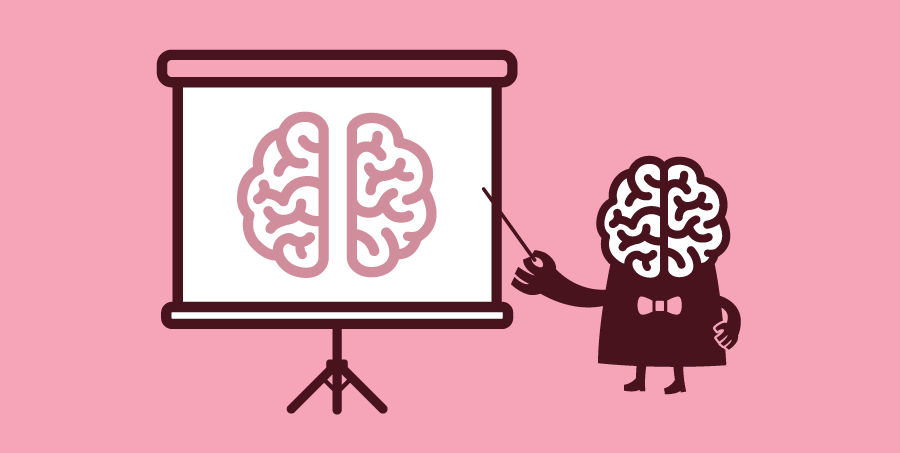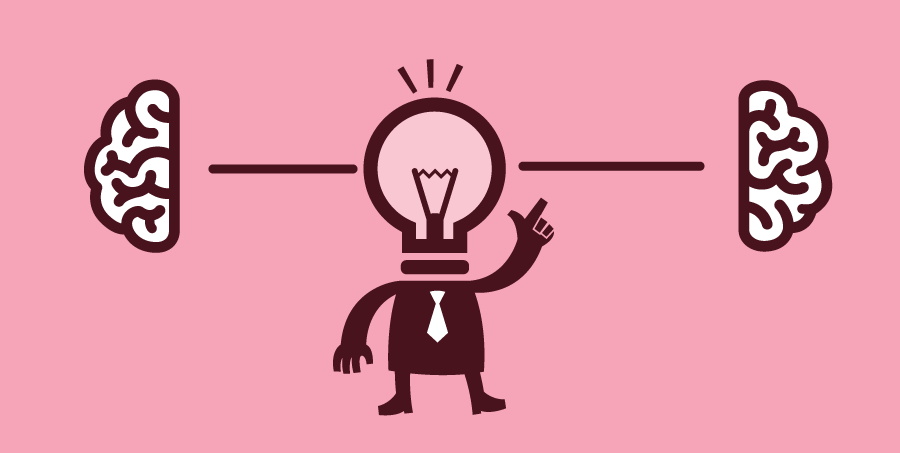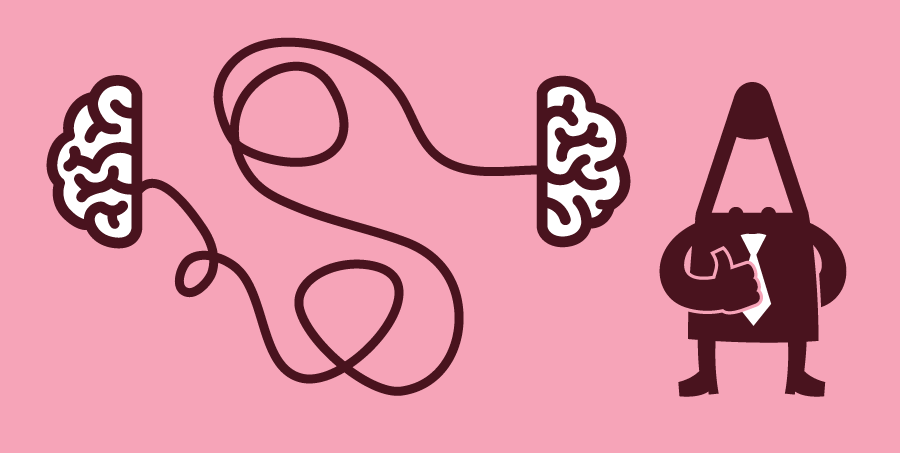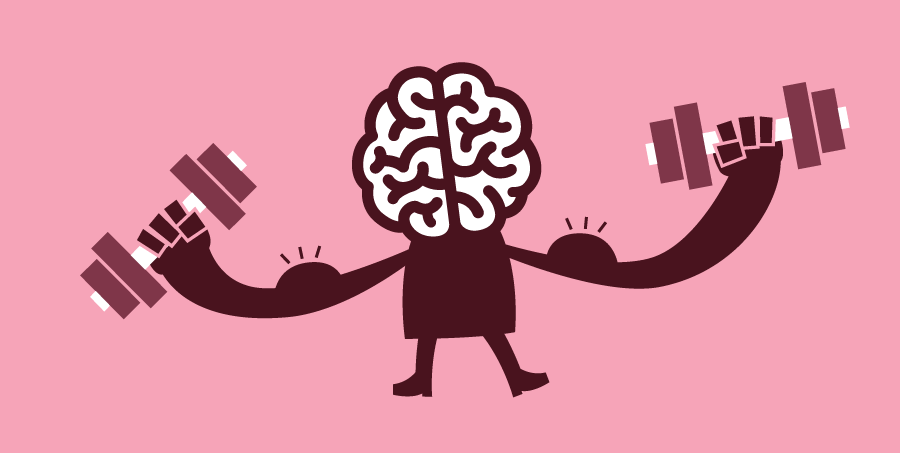Designers have been told that they have a gift, or are somehow different or more creative. They've been classified as right-brain thinkers. We know the brain is divided into two hemispheres — the common notion, psychologically, is that the left side of the brain holds language and is more logical, while the right brain is more creative. The problem is, it's not true.
Creatives are right brain dominant, or so the theory goes. Over time we've perpetuated a myth that designers have been given special creative talents. It's hurting our ability to create great products.
Moving Beyond Creative Stereotypes
Research has shown that it's not that simple. We use our whole brain. In our last article on gut-thinking, we discussed the problem with companies not trusting designers — part of this lack of trust is built on the myth that creatives might lack the sense of logic or reason that comes with left-brain thinking. Designers perpetuate this logic by suggesting they have 'taste' and are better at all the user stuff.
Taste is a component of design, for sure, but a more significant problem facing designers is that they're not learning to bring experiences together. There is research to perpetuate the idea that some are creatively gifted, but it's not because of their talents, but the socialization that happens in our education system:
Of 1,600 children aged three to five who were tested, 98% showed they could think in divergent ways. By the time they were aged eight to 10, 32% could think divergently. When the same test was applied to 13 to 15-year-olds, only 10% could think in this way. And when the test was used with 200,000 25-year-olds, only 2% could think divergently . . . Education is driven by the idea of one answer and this idea of divergent thinking becomes stifled.
Designers need to bring divergent thinking to organizations. They also need to find the overlap in critical thinking in different parts of an organization. To create real impact and success in companies, designers are going to have to work much harder at connecting their own experiences across disciplines to create value for users.
What We Know About the Brain

The right brain, according to the left-brain, right-brain dominance theory, is best at expressive and creative tasks. Abilities popularly associated with the right side of the brain include: recognizing faces; expressing emotions; music; reading emotions; color; images; intuition; and creativity. The left side of the brain is considered to be adept at tasks that involve logic, language and analytical thinking. The left-brain is described as being better at language, logic, critical thinking, numbers, and reasoning.
While many of these core functions have their roots in a specific portion of the brain, the science is actually much more complex. The connective tissues that bind the left and right brain play a large role in amplifying thoughts:
It turns out though, that we use virtually every part of the brain, and that [most of] the brain is active almost all the time. Let's put it this way: the brain represents three percent of the body's weight and uses 20 percent of the body's energy. - Neurologist Barry Gordon of Johns Hopkins School of Medicine, Scientific American
The corpus callosum carries electrical signals between both sides of the brain. It stretches nearly the full length of the brain from behind the forehead to the back of the neck and is the dense network of neural fibers that make brain regions with very different functions work together. This part of the brain, however, is still a great mystery as scientists try to figure out how this complex network of neural fibers works.
The Einstein Genius
A recent study on Einstein's brain found that he had a larger corpus callosum than the average person. Interestingly, Einstein was an excellent musician and some studies have suggested that his interest in music may have contributed to this abnormality. Einstein stated, 'If I were not a physicist, I would probably be a musician. I often think in music. I live my daydreams in music. I see my life in terms of music.'
What's interesting about one of the greatest thinkers of the last century is how he thought.
Einstein first described his intuitive thought processes at a physics conference in Kyoto in 1922, when he indicated that he used images to solve his problems and found words later (Pais, 1982). Einstein explicated this bold idea at length to one scholar of creativity in 1959, telling Max Wertheimer that he never thought in logical symbols or mathematical equations, but in images, feelings, and even musical architectures. -Michele and Robert Root-Bernstein, Psychology Today
One of the world's greatest thinkers thought in images. Amazing! But what is of more interest to designers is that he found words later. Today we might define this way of thinking as design thinking.
Another finding from the research on Einstein's brain suggested that his genius may not have been caused by the size of his brain. Rather his brain was larger in those connected areas between hemispheres because he exercised those areas more than the average person. Researchers have found that enriched learning environments can help contribute to the survival and integration of new brain cells. It seems that genius maybe rooted in working different parts of the brain with regularity.
Expanding our Design Literacy

Product designers must practice and expand the critical thinking parts of their brain to reach the rest of their organizations. Critical thinking becomes a bridge to connect with employees who might have been conditioned by society, traditional schooling and corporate structures to only think analytically. Designers can facilitate design thinking, but they need to overlap their experiences with the knowledge that organizations already hold, specifically critical thinking.
Designers have the ability to show the rest of the organization how to bring experiences to the forefront — they practice more than the average worker to bring creativity to their work.
Artists showed lower activity in part of their frontal lobes called the dorsolateral prefrontal cortex during improvisation, and increased activity in another area, called the medial prefrontal cortex. The areas that were found to be 'deactivated' are associated with regulating other brain functions.
Design literacy across a business is necessary if companies are to become more design centric. At ZURB, we've been using progressive design to bring the knowledge of a team into the design process. Making connections is key to making this happen, as Steve Jobs eloquently captured in this 1996 Wired article:
Creativity is just connecting things. When you ask creative people how they did something, they feel a little guilty because they didn't really do it, they just saw something. It seemed obvious to them after a while. That's because they were able to connect experiences they've had and synthesize new things. And the reason they were able to do that was that they've had more experiences or they have thought more about their experiences than other people.
Unfortunately, that's too rare a commodity. A lot of people in our industry haven't had very diverse experiences. So they don't have enough dots to connect, and they end up with very linear solutions without a broad perspective on the problem. The broader one's understanding of the human experience, the better design we will have. — Steve Jobs
While the vast majority of workers stay siloed in their organizations, most designers are guilty of failing to learn across the organization. The over productionalization of design forces most organizations into a factory line of critical thinking, which kills innovation.
So where do we start? Practice.
Designer Practice Makes Designer Perfect

In product design, you carry a lot of design decisions in your head. Learning to prioritize those ideas and get them written down allows our brains to focus on processing ideas — not carry the baggage of stress or product team problems. You can't make gut-thinking decisions with mental baggage. In a production line model, designers spend too much time using their brains as production tools — which is ultimately a Photoshop button replacement.
We've talked in the past about how design collaboration is lonely. And for designers to truly collaborate in a meaningful way, there needs to be more attention to practicing critical thinking as part of the design process. Designers can't make the necessary connections across an organization without first learning and practicing to articulate their ideas. This happens through writing and sketching.
For designers to be successful, getting ideas out of your head takes practice, but the effects of writing and sketching have immense implications on the satisfaction of one's work. People feel more engaged, more productive, and have a greater sense of meaning in their work when they record even the most minuscule of accomplishments. Design teams can capture this power if they learn to harness these skills in designers. Most designers stop at visual communication. Or don't have the skills to articulate their ideas.
Designers must learn to sell their ideas through writing them down. Persuasion happens with confidence, and learning to articulate ideas through words can help build confidence. Designers also need to ask more questions. While most professionally-trained designers have learned the art of the critique, most educational systems still lack the training necessary to drive the dialog through a complete design process with a cross disciplinary team. We started talking about progressive design recently and a clear benefit of learning to write in this model is that it encourages designers to sell and purge ideas to keep momentum in a project.
Exercising Our Brains

We've committed ourselves to writing and fostering ideas in Tavern to grow and shape product design. With the shutdown of Forrst, we asked ourselves how we could learn from inviting designers into discussions on a broad range of product design topics, all while keeping the format simple. We took the banana leaf parable to heart. What can we write in a day on a topic? How does the commitment to these ideas shape the way we solve problems everyday?
We're just over 100 days into Tavern. It's been an amazing opportunity to grow and learn with a group of designers. Learning to question and challenge ideas is a core part of what being a product designer is all about. Product design is a horizontal discipline that requires significant investments among team members. Tavern has become a structured environment to keep the learning extremely focused. One hundred days in, we've had nearly 5,000 contributions from some amazing and articulate designers like Ren Walker, Bryce Howiston, and Antonin Januska.
As we explore the broader goals of product design with designers through Tavern and the University, we're also working hard to release improved tools that help design teams facilitate better design communication through an improved Notable. We're all in on trying to figure out how to build strong design teams through progressive design. We even share our team building exercises in our Friday15 site.
Progressive Design [Thinking]
Twitter quips, weather apps and Dribbble shots are part of the design lexicon. They've engrained simplicity in designers' heads and helped people find creative outlets. But there's a difference between creating a simple result and oversimplifying the problem. Being 'creative' or a' right brain thinker' isn't going to solve our problems without more attention to actual thinking. We solve this at ZURB through progressive design by taking a practical approach to design thinking.
A designer's job is to help companies figure out how to make the complex, simple. This requires a commitment to selling ideas internally and moving their team through a creative process. It requires gut-thinking — thinking that's evolved by overlapping convergent and divergent thinking, synthesizing company knowledge together with customer feedback and using experience to drive decisions. Effective designers must continually practice these skills in their work and find connections across organizations. It's not just a right brain activity. And companies shouldn't make it that.
Companies need designers to make decisions from the gut to move quickly through a design process. But it's not going to happen without regular training and practice. Designers need to commit to ideas and sell visions that can be understood by a wide range of people across a business. When designers figure out how to do this, companies will in turn trust designers to think from their gut.

Bryan Zmijewski
Leading the charge at ZURB since 1998
Our fearless leader has been driving progressive design at ZURB since 1998. That makes him quite the instigator around the offices, consistently challenging both the team and our customers to strive to always do better and better.
Learn more →
Follow him at @bryanzmijewski
